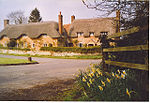Betty Mundy's Bottom

Betty Mundy's Bottom is a wooded valley in the South Downs of Hampshire. There are a variety of folk tales about the name, which goes back centuries. One theory is that it is from the Latin beati mundae, meaning the most beautiful place in the world. Another has it that Betty Mundy lived in a cottage there and that she would waylay discharged sailors walking along the Sailor's Lane, murdering them for their wages or leading them to a press gang. Other stories are that she was a witch or fairy that would curse or trick people.In 1941, there was building work to renovate two cottages owned by Major Pelly. In 2012, a substantial country house known as Mundy's House was rebuilt there.
Excerpt from the Wikipedia article Betty Mundy's Bottom (License: CC BY-SA 3.0, Authors, Images).Betty Mundy's Bottom
Mundy’s Walk, Winchester Exton
Geographical coordinates (GPS) Address Nearby Places Show on map
Geographical coordinates (GPS)
| Latitude | Longitude |
|---|---|
| N 50.99679947 ° | E -1.17394469 ° |
Address
Mundy’s Walk
SO32 3LP Winchester, Exton
England, United Kingdom
Open on Google Maps








